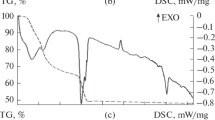Glass-ceramic materials in the systems SiO2–Al2O3–RO (RO — MgO, SrO, BaO, and their combinations) were synthesized by the sol-gel method. The factors influencing the sol-gel formation process educed. The effect of the composition and temperature-time regimes of heat treatment on the crystallization properties of gels, phase transformations, phase composition, granulometry, and shape of the resulting particles was investigated. The nature of the phase transformations occurring in powders was educed as a function of the temperature- time conditions of heat treatment. It is shown that, depending on the composition, anorthite or its solid solutions are the dominant crystalline phases, and their formation temperatures were determined: hexagonal celsian at 1350°C, monoclinic strontium anorthite at 1400°C, and cordierite at 1450°C. The effect of pressing and heat treatment on the physicomechanical, dielectric, and thermal properties of the obtained materials was investigated.










Similar content being viewed by others
References
V. L. Balkevich, Technical Ceramics [in Russian], Stroiizdat, Moscow (1984).
E. N. Kablov, “Materials of a new generation—the basis of innovation, technological leadership, and national security of Russia,” Intellekt i Tekhnologii, No. 2(14), 16 – 21 (2016).
E. N. Kablov, B. E. Zhestkov, D. V. Grashchenkov, et al., “Investigation of the oxidation resistance of a high-temperature coating on SiC material under the influence of a high-enthalpy flow,” Teplofiz. Vys. Temp., 55(6), 704 – 711 (2017).
D. V. Grashchenkov, “Strategy for the development of non-metallic materials, metal composite materials, and thermal protection,” Aviats. Mater. Tekhnol., No. S, 264 – 271 (2017).
S. A. Evdokimov, N. E. Shchegoleva, and O. Yu. Sorokin, “Ceramic materials in aircraft engine building: a review,” Tr. VIAM: Elektron. Nauch.-Tekhn. Zh., No. 12, Art. 06 (2018).
V. S. Bakunov, A. V. Belyakov, E. S. Lukin, and U. Sh. Shayakhmetov, Oxide Ceramics: Sintering and Creep [in Russian], RKhTU im. D. I. Mendeleeva, Moscow (2007).
O. Burgos-Montes and R. Moreno, “Colloidal behavior of mullite powders produced by combustion synthesis,” J. Eur. Ceram. Soc., 27(16), 4751 – 4757 (2007).
G. Remzi, E. Bahri, Ö. Cem, et. al., “Colloidal stability-slip casting behavior relationship in slurry of mullite synthesized by the USP method,” Ceram. Int., 38(1), 679 – 685 (2012).
W. Pichor and A. Janiec, “Thermal stability of expanded perlite modified by mullite,” Ceram. Int., 35(1), 527 – 530 (2009).
T. C. De Oliveria, C. A. Riberio, D. D. Brunelli, et. al., “The kinetic of mullite crystallization: Effect of water content,” J. Non-Cryst. Solids, 356(52 – 54), 2980 – 2985 (2009).
B. Bagchi, S. Das, A. Bhattacharya, et. al., “Nanocrystalline mullite synthesis at low temperature: Effect of copper ions,” J. Am. Ceram. Soc., 92(3), 748 – 751 (2009).
D. Ribero, R. Restrepo, C. Paucar, et. al., “Highly refractory mulitte obtained through the route of hydroxyhydrogels,” J. Mater. Proc. Technol., 209(2), 986 – 990 (2009).
N. T. Andrianov, T. D. Nikolaeva, and S. S. Strelnikova, “Synthesis and sintering of mullite obtained by the sol-gel method,” in: Abstracts of Reports at All-Russ. Conf. on Physicochemical Issues of Developing Special and General Purpose based on Synthetic and Natural Materials [in Russian], Komi Scientific. Center, Syktyvkar (1997), p. 64.
E. V. Stepanova, D. E. Sharygin, and Yu. B. Shvalev, “Influence of precipitation conditions on the physicochemical characteristics of aluminum hydroxide,” Izv. Tomsk. Politekh. Univ., No. 1, 99 – 101 (2004).
V. A. Voronov, Yu. E. Lebedeva, O. Yu. Sorokin, and M. L. Vaganova, “Investigation of the protective action of a coating based on yttrium-aluminum-silicate system based on silicon carbide material exposed to an oxidative atmosphere,” Aviats. Mater. Tekhnol., No. 4, 63 – 73 (2018).
D. V. Grashcehkov, M. L. Vaganova, N. E. Shchegoleva, et al., “High-temperature glass-ceramic material of barium aluminosilicate composition obtained using sol-gel synthesis, and composite materials based on it,” Aviats. Mater. Tekhnol., No. S, 290 – 305 (2017).
E. S. Kulikov, Bi- (Re–Ru) and Trimetallic (Re–Ni–Ru) Alkoxy Derivatives: Synthesis, Structure, Properties, Author’s Abstract of Candidate’s Thesis [in Russian], Moscow (2019).
E. N. Kablov, “Innovative developments of FSUE VIAM of the State Scientific Center of the Russian Federation for the implementation of ‘Strategic lines of the development of materials and technologies for their reprocessing in the period up to 2030’,” Aviats. Mater. Tekhnol., No. 1, 3 – 33 (2015).
Author information
Authors and Affiliations
Corresponding author
Additional information
Translated from Steklo i Keramika, No. 4, pp. 3 – 15, April, 2022.
Rights and permissions
About this article
Cite this article
Shchegoleva, N.E., Lebedeva, Y.E., Voronov, V.A. et al. Sol-Gel Production of Alkaline-Free Aluminosilicate Glass Ceramic and Investigation of its Properties. Glass Ceram 79, 121–129 (2022). https://doi.org/10.1007/s10717-022-00468-3
Received:
Published:
Issue Date:
DOI: https://doi.org/10.1007/s10717-022-00468-3




